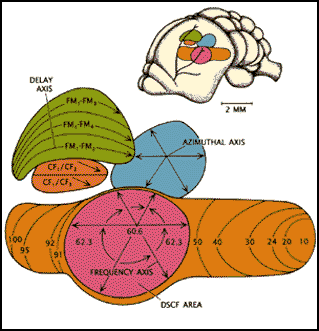Echolocation In Microbats
Ultrasound Foraging in Microchiroptera
Patrick Fink: 2007
Mechanism
What is mechanism? Mechanism is the sum total of proximate causes and
physical processes that comprise an animal behavior.
Nuts and Bolts:
How do bats echolocate? The most basic concept is illustrated in the image below:
While this animation may be extraordinarily simplistic in its model of echolocation, it is good to keep this visual in mind as we discuss the more complicated mechanisms so that we do not lost sight of their purpose.
Not all bats echolocate in the same way. Some bats use a CF (constant frequency) sonar portion, some an FM (frequency modulated sweep), and some a combination of the two. Each of the two, CF and FM, server a different purpose. CF echolocation is best suited to detection of targets (read: dinner) and determining doppler shift. FR echolocation is best for honing in on the details of an object and for more precisely determining its distance. The choice between CF and FR may depend on the bat's environment.
Harmonics:
When bats produce either a CF or an FM pulse (or both as with the figure below), they produce not only the primary frequency, but a number of harmonics related to their primary frequency.

Of great interest is often the second harmonic, which both serves as the best measure of Doppler shift (so that the bat might correct it heading for its own speed) and as an identifier of the bat's call. The pattern of harmonics is slightly different and thus unique among bats, so that many bats echolocating in the same space can distinguish their calls from those of the bats around them.
Approach & Capture:
When a bat begins its echolocation it usually makes short millisecond long pulses of sonar and listens for the returning echoes (see above). If the echo indicates prey, it will generally fly towards the source of the echo while continually emitting pulses of increasing rapidity and shorter duration. When the bat reaches its prey it continues to issue pulses right up until the moment that the prey is captured and eaten.
Neurology/Physiology:
As echolocation is a highly evolved and precise behavior, it follows that the microchiropteran posessed a highly evolved and precise neural mechanism to interpret the data that it recieves from echolocation. Bats have ears in the style of most other membranes (See More), however, the basilar membrane of the middle ear is thickened in areas so as to be far more attuned to the range of Hz issued by the bat. Specifically, it it most finely attuned to the Doppler shift-compensated 2nd harmonic. Many other parts of the inner ear are also tuned to these same frequencies.
From the echo that the bat recieves, it is able to decode many pieces of information about its target and surroundings, including: relative velocity of a target, flutter of target, range, size, fine characteristics, azimuth and elevation. This information is encoded in the amplitude of returning echoes, in the delay between echo and pulse, the Doppler shift between pulse and echo, and many other combinations of these factors.
The amazing (99%) accuracy of the bat's calculations does not come from specialization in the ear alone. The bat's brain is also highly developed, specifically in the CF-CF area (dark orange), in the FM-FM area (light green), and in the DSCF area (pink)in the auditory cortex.

Specific parts of these areas respond to specific frequencies of recieved signal. When the bat's prey, the flying insect, beats its wings, it creates a small doppler shift on top of the doppler shift caused by the bat's own movement. The neuropathways in the bat's auditory cortex are so refined that this small wavering can be detected, which leads the bat to its target.
Figures on this page from Suga, N. (1990). Bisonar and neural computation in bats. Sci. Amer. 262:60-68.